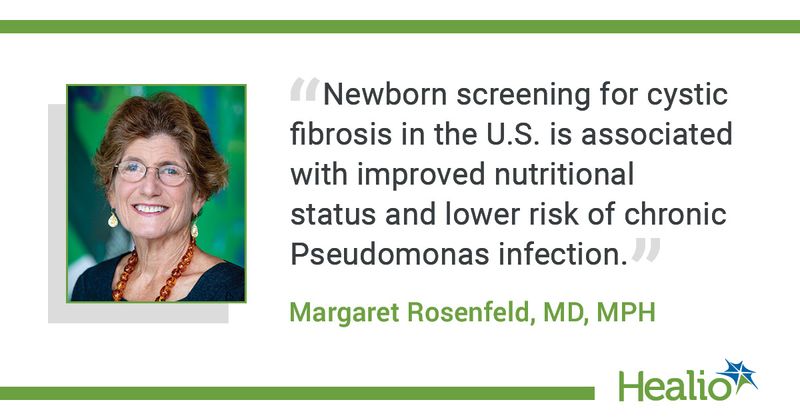US cystic fibrosis newborn screening programs led to improved nutritional, pulmonary outcomes
In the U.S., newborn screening programs for cystic fibrosis were associated with improved nutritional status up to middle childhood, rapid increases in lung function and delayed chronic Pseudomonas aeruginosa infection, researchers reported.
There has been universal use of newborn screening programs for cystic fibrosis in the United States since 2010. Researchers aimed to assess the real-world effectiveness of these programs on clinical outcomes up to age 10 years.

“The existence of the Cystic Fibrosis Foundation National Patient Registry, which contains detailed demographic and clinical data on almost all individuals with cystic fibrosis in the United States, allowed us to undertake the largest study to date of outcomes associated with the implementation of newborn screening for cystic fibrosis,” Margaret Rosenfeld, MD, MPH, attending physician in the division of pulmonary and sleep medicine at Seattle Children’s Hospital and the department of pediatrics at the University of Washington, Seattle, told Healio.
The retrospective cohort study included data from 9,571 participants (49.2% girls) from the Cystic Fibrosis Foundation Patient Registry. All children had a diagnosis of cystic fibrosis and were born between 2000 and 2018 in any 44 U.S. states that implemented newborn screening for cystic fibrosis between 2003 and 2010. Researchers used the implementation of newborn screening programs by state to compare longitudinal outcomes in children in the same cohort born before and after newborn screening for cystic fibrosis implementation in their state.
The primary outcome was longitudinal trajectory of height and weight percentiles from cystic fibrosis diagnosis, lung function after age 6 years, and age at initial and chronic infection with P. aeruginosa, according to the study.
Nearly half (47.1%) of participants were in the pre-newborn screening cohort.
Newborn screening was associated with higher median annualized weight percentiles (difference = 6) and height percentiles (difference = 6.6) during the first year of life; these differences decreased with age compared with participants in the pre-newborn screening group. The differences in weight and height percentiles persisted through age 10 years, according to the results.
Researchers reported no associations between newborn screening and FEV1 at age 6 years. However, percent predicted FEV1 increased more rapidly with age in participants in the post-newborn screening cohort.
Newborn screening was also associated with older age at chronic P. aeruginosa infection (HR = 0.69; 95% CI, 0.54-0.89) but was not associated with initial infection (HR = 0.88; 95% CI, 0.77-1.01).
“Newborn screening for cystic fibrosis in the U.S. is associated with improved nutritional status and lower risk of chronic Pseudomonas infection; there is no clear association with lung function up to age 10 years,” Rosenfeld told Healio.
The researchers said future research should include longer follow-up, especially for lung function, which can only be measured starting at age 6 years.
“Also, once cystic fibrosis transmembrane conductance regulator modulator therapies are available starting in infancy, evaluating the effects of early initiation of these therapies after diagnosis by newborn screening will be critical,” Rosenfeld said.
For more information:
Margaret Rosenfeld, MD, MPH, can be reached at margaret.rosenfeld@seattlechildrens.org.
